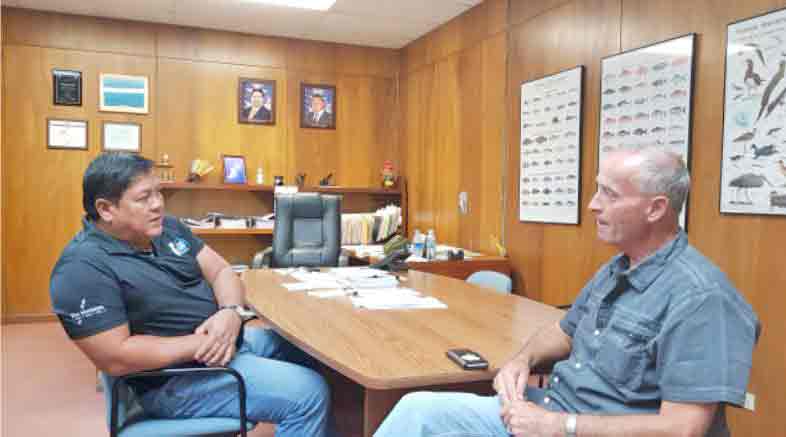USDA official recommends 1-year time frame for rhino beetle eradication

Department of Lands and Natural Resources Secretary Anthony Benavente, left, meets with Dallas Berringer of the U.S. Department of Agriculture’s Animal and Plant Health Inspection Service Guam. (Contributed Photo)
Department of Lands and Natural Resources Secretary Anthony Benavente met with Dallas Berringer of the U.S. Department of Agriculture’s Animal and Plant Health Inspection Service Guam to discuss the ongoing coconut rhino beetle eradication process on Rota.
Benavente noted that more netting traps will be deployed along with salt water spraying for sanitation.
“One adult CRB was caught entering a trap last week and while we’ve identified short-term resources over the last couple months, we continue to procure supplies and work with local and federal officials regarding our eradication needs,” Benavente said.
Berringer added that it would be best to allow one year to determine if the eradication process is complete.
As a precaution, he noted that a thorough survey of the Wedding Cake Mountain needs to be conducted and that USDA-APHIS is willing to use their drone to assist. At the same time, USDA will need to get clearance from the Federal Aviation Administration to operate.
Gov. Ralph DLG Torres underscored the urgency of the eradication process and continues to encourage the collaboration between federal and local officials.
“The coconut rhino beetle is one of many invasive species that our team is working diligently to combat. This continues to be a critical priority, and the ongoing collaboration is crucial to eradication. I thank Secretary Benavente, our CNMI Invasive Species Coordinator Ray Roberto, our team in Rota, and USDA-APHIS for their continued collaboration,” Torres said.
Torres added that CNMI Invasive Species coordinator Ray Roberto is closely working with Rota staff to monitor the operation and will be assembling a team from Rota, Saipan, Tinian, and the Northern Islands for further training at the eradication program in Guam to increase bio-security.
Solar lamps installed against rhino beetles
Benavente also reported that ongoing coconut rhino beetle containment efforts include using eight solar powered lamps to keep nocturnal CRBs at bay.
“We’re continuing to map out the infestation in the area, and destroying the breeding sites and affected coconut trees. Last month, our team discussed the quarantine of the Tweksberry area, and that bright lighting is needed during the evening hours to keep hidden CRBs from flying outside the quarantine. Preventing further spreading has been successful, and we learned that the farthest CRBs have been detected is in an adjacent property to Tweksberry,” Benavente said, noting that a daily collections report for CRBs is ongoing, along with land clearing procedures.
Strategic CRB Action Plan for 2017 to 2022
Benavente also shared that a Strategic Action Plan for 2017 to 2022 has been put into place toward coconut rhino beetle prevention, detection, and eradication.
Recently reviewed by the Agriculture Advisory Council, Benavente stated that the plan includes standard operating procedures moving forward.
Building and maintaining capacity including rapid response, risk analysis and public engagement, he says, is critical to controlling the impact.
“When coconut rhino beetles were discovered in October of last year, our efforts were expedited as we know the current impact of CRB’s in Guam and neighboring regions. Additionally, we’ve found that the beetle is also known to feed on economically important commercial crops such as bananas, sugarcane, papayas, sisal, pineapples, and date palms. Even though CRBs have a short lifespan, in our climate, the beetle can reproduce throughout the year, making these consistent efforts all the more important,” he said.
Torres reiterated that in combating CR’s and invasive species overall, the strategic action plan aims to mitigate threats to all natural resources.
“I commend DLNR’s steadfast action and progress in combating invasive species and putting forth a plan of action to prioritize our resources and efforts. I am assured that we will continue to push plans for mitigation now and in the months ahead, Torres said.
For more information call CNMI Forestry at 256-3321 or Department of Lands and Natural Resources at 322-9834. (PR)



























